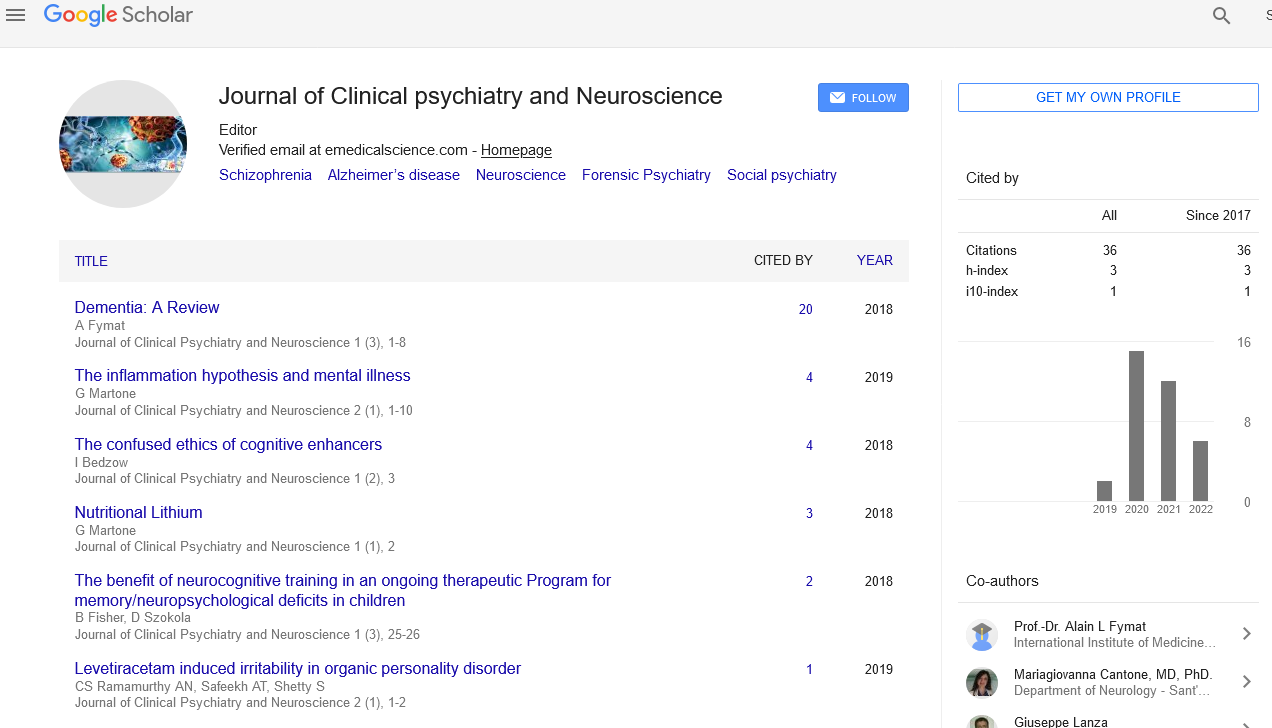Psychiatry's use of coercion
Received: 03-Mar-2023, Manuscript No. puljcpn-23-6396; Editor assigned: 04-Mar-2023, Pre QC No. puljcpn-23-6396 (PQ); Accepted Date: Apr 24, 2023; Reviewed: 15-Mar-2023 QC No. puljcpn-23-6396 (Q); Revised: 17-Mar-2023, Manuscript No. puljcpn-23-6396 (R); Published: 27-Apr-2023, DOI: 10.37532/puljcpn.2023.6(2). 101-02
Citation: Lao M. Psychiatry's use of coercion. J Clin Psychiatry Neurosci. 2023; 6(2):101-02.
This open-access article is distributed under the terms of the Creative Commons Attribution Non-Commercial License (CC BY-NC) (http://creativecommons.org/licenses/by-nc/4.0/), which permits reuse, distribution and reproduction of the article, provided that the original work is properly cited and the reuse is restricted to noncommercial purposes. For commercial reuse, contact reprints@pulsus.com
Abstract
The use of force or intimidation to persuade someone to perform in a certain way is known as coercion. Coercion is occasionally the only workable option available to prevent impending damage in the typical low resource realm of psychiatry, with behavioral crises and diminished competence to make treatment decisions. Coercive practices in psychiatry have historically been linked to iatrogenic damage, poor patient satisfaction, and an increased risk of suicide attempts, leading to calls for their reduction on a global scale. A different strategy is required since straightforward rules frequently are unable to handle the complexity of addressing behavioral crises fairly in order to reduce harm. A nationwide patient safety policy is lacking, particularly in Canadian psychiatric practice.
Key Words
Suicide Attempt; Coercive Behaviors
Introduction
According to the principles of equality, diversity, and inclusion in medicine, reducing harmful coercive behaviors may be possible. The decrease of patient actions that can lead to the employment of coercive practices, as well as the addressing of clinician biases, are some potential advantages of applying traumainformed care practices in psychiatry. In response to Waddell and Gratzer's call to action, we think these ideas can help us build national standards surrounding patient safety.
According to a systematic study, raising the voices of patients and assisting careers can lessen the harm caused by restrictions and confinement. Even though non-consensual use of physical and chemical restraints is common, factors that influence how a patient perceives restraints include feeling a "loss of self-respect and dignity" and "less safe." The risk of psychological injury is reduced through debriefings with the patient and making an effort to make people feel heard while applying restraints.
Inpatient or community-based treatment orders and certification under a mental health act are the three legal options to compel treatment in Canada. Community Treatment Orders (CTOs) are court-issued directives that require patients to follow supervised mental health treatment regimens while residing in the community.
A thorough analysis of qualitative research revealed that patients' experiences with CTOs might be unfavourable. For instance, several participants described feeling "emotionally threatened," as well as having their freedom taken away and being trapped in a system designed to control them. Throughout the course of treatment, collaborative decision-making lessens the detrimental effects of CTOs.
The goal of the trauma-informed care method is to identify and comprehend how people's previous experiences shape how they express themselves in the present so that healthcare professionals can react in a way that promotes psychological safety. This entails paying attention to unequal power relations during patient contacts, which might trigger trauma reactions to earlier frightening experiences. This method emphasizes openness and a thoughtful, cooperative stance that maximizes patient empowerment and choice. It may be helpful for a variety of people, including those who have dealt with relational stress, attachment injury, childhood adversity, or stereotypes and injustices based on race, gender, or culture.
Implementing trauma-informed treatment in inpatient settings has been linked to decreased use of restraints and isolation, as well as fewer injuries to patients and staff, according to a systematic study. One nurse stated, "The person may have still needed to be restrained but we were able to use less restraint and I think a lot of that was through actually engaging the person in the whole process...so we were trying to work with them as much as possible, too," in a study using a mixed-methods approach. Essentially, the use of traumainformed care has the ability to lessen the need for coercive methods and in situations when coercion is the only option, it can function as a buffer against the iatrogenic psychological harm that can result from such methods.
If leadership is trauma-informed, a transition to trauma-informed care will probably make EDI easier for larger systems while also lowering coercion. At its foundation, EDI emphasizes eliminating structural obstacles to equitable treatment and access, respecting individual differences, and making sure that all perspectives are heard; these principles are inadvertently fulfilled when trauma-informed care is applied. The body of research describing attempts to apply EDI to healthcare is still in its infancy, but it is growing quickly as EDI and an intersectional lens are accepted as desirable qualities. Traumainformed care respects variety by starting from the premise that each person has a distinct viewpoint that is colored by prior encounters, cultural context, and historical events. Acknowledging how historical and cultural influences may contribute to hardship and traumatic experiences.
Recent epidemiological research that supports the critical role of past trauma and adversity in mental illness across a range of psychiatric diagnoses, as well as the high prevalence of trauma reported in marginalized groups like racial and gender minorities, highlight the necessity of implementing trauma-informed care in psychiatry. Trauma history has been found to have a detrimental influence on wellbeing and to be linked to socioeconomic deprivation, even if not all patients may experience aftereffects on their mental health as a result of this exposure. Trauma-informed care may provide a tangible step forward in educating clinicians to be in line with EDI priorities in clinical practice and enhance patient safety in Canadian psychiatric practice, in line with Waddell and Gratzer's call to action. This is true whether addressing overt traumatic sequelae or the detrimental effects of micro aggressions and discrimination.





